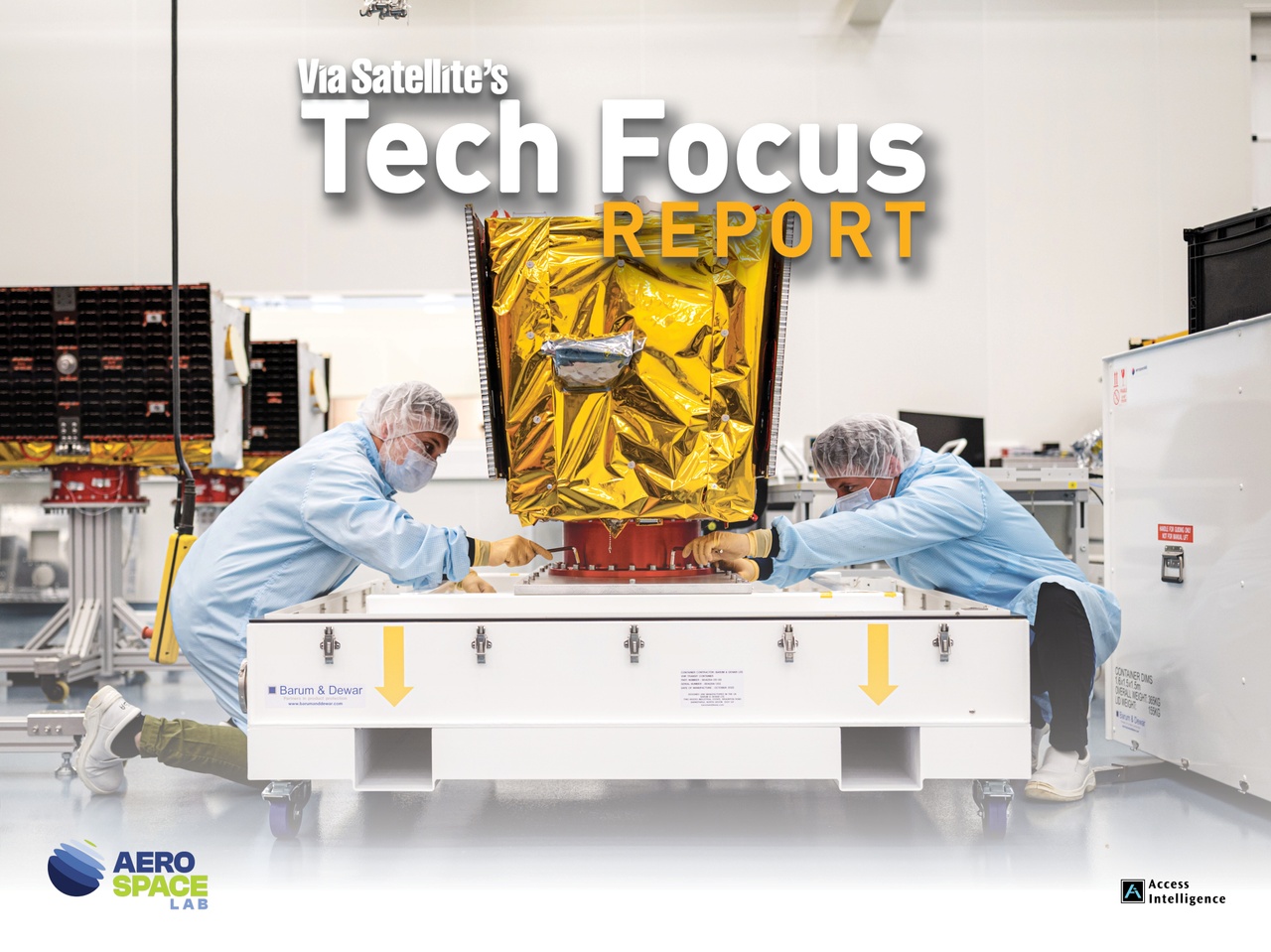
Where Does the GEO Piece Fit in Satellite’s Future?
Despite the infatuation with LEO, cutting edge technologies like 3D printing, smallsats, and software-defined satellites are reinvigorating interest in GEO. July 24th, 2023
We’ll always need GEO, even in a world that’s gone head over heels for LEO.
It’s a matter of physics: The Geostationary Orbit (GEO) has unique characteristics. Because a satellite in GEO stays at a fixed point in the sky relative to any location on the ground, it’s the simplest orbit to communicate with, in terms of both technology and expertise. You point the dish, you bolt it on, you’re finished.
Partly due to these physics, despite the industry’s current infatuation with Low-Earth Orbit (LEO), and the transformation that Starlink and its emerging competitors have wrought in the satellite connectivity market, GEO remains the major revenue driver globally for satellite connectivity across most enterprise sectors.
And cutting edge technologies like 3D printing, smallsats, and software-defined satellites are making new use cases for GEO a viable business proposition.
“It won’t surprise you to know that we believe GEO has a future,” Eve Berneke, CEO of Eutelsat Group, the operator which owns the OneWeb LEO constellation, tells Via Satellite.
The traditional use cases for GEO — nonsynchronous consumer applications like live and on-demand video broadcast; and resilient fallback networks for governments and other low/no failure tolerance customers — will continue to be revenue streams for many years to come, Berneke says.
“If you want low-cost TV distribution in Africa, you're going to go with GEO,” she adds, because a terminal that looks at one fixed, geostationary point in the sky is cheaper and simpler to maintain than one which has to track a LEO satellite as it moves across the sky.
Berneke’s comments are borne out by the numbers in at least one enterprise vertical: Maritime.
Last year, revenue from GEO end users in the maritime sector was $1.29 billion, compared with just $338 million for LEO, says Joshua Flood, a senior consultant at mobility consulting firm Valour Consultancy. But while GEO revenues are slowly declining, LEO is growing fast. Flood expects LEO revenues in the maritime sector to surpass GEO by 2028.
GEO has been a cash cow for operators and resellers for decades, with profit margins as high as 30 percent explains Flood. While revenues from traditional services like video and VSAT are slowly declining, new use cases are emerging.
“There is a reason why venture capital and private equity funds have purchased GEO operators and resellers like Inmarsat, Marlink, and Speedcast. And it’s not because they’re Star Trek fans,” Flood says. “These companies make money. GEO is here to stay.”
Multi-Orbit Integration
But given stagnating or slowly declining revenues from traditional use cases like video, operators are getting creative — identifying new use cases and leveraging GEO assets in novel ways.
The future lies in seamless multi-orbit integration, Berneke says, which will position operators to benefit from the growing market: “We all know there will be connectivity growth in satellite. However, how it will split between GEO and LEO will depend a lot on how good the products are and how much of a seamless integration we can have between the orbits.”
That seamlessness underlies a good customer experience, but it also helps operators control costs, because GEO constellations are more cost efficient, Berneke says. “You can have a higher utilization on a GEO asset than you'll ever get on a LEO constellation,” in which the satellites spend up to a third of their time over the empty oceans. “So the better you can offload [network traffic to GEO] the more efficient you can be.”
The technology needed for that integration already exists, but productizing it was complicated, she says. Some instances just require an SD-WAN overlay and two antennas and two modems. But other use cases like in-flight connectivity (IFC) require more complicated antennas. “You need an integrated antenna, and you want it as small as possible, and you want it in exactly the same form factor as the previous ones,” Berneke says of IFC.
Because the key to seamless multi-orbit integration lies in ground-based technologies like terminals, modems, and network orchestration, the time horizon for implementation is three to five years, she says.
In the slightly longer term, she adds, satellite connectivity will become part of the mobile ecosystem, along with cell towers and Wi-Fi hotspots, and just as invisible to the user.
“Our vision is to stand on top of the mobile ecosystem rather than having our baseband [receivers] as full stack standalones. We’re pushing hard for shared standards with the rest of the connectivity ecosystem. Starlink and Amazon [Kuiper], they're doing their own [proprietary] technology end-to-end. But we believe the future lies with open standards and integration into the 5G and 6G mobile ecosystem.”
Both Starlink and Amazon Kuiper are vertically integrated, meaning like with Apple products, they are a walled garden. This has its own benefits to the companies and users, but offers no integration or interoperability with other companies’ products.
Starlink builds and launches its own satellites and makes its own receiver dishes. The model Eutelsat is supporting would function more like the Android ecosystem, with open standards allowing every manufacturers’ products to work seamlessly together.

Going Small in GEO
The use of GEO to integrate satellite connectivity into the mobile ecosystem is just one of the new use cases emerging that can exploit the unique characteristics of GEO as long as the price of access is low enough, explains Emile de Rijk, CEO and co-founder of Swissto12, a company which began using cutting edge manufacturing technologies like 3D printing to make high capability RF antennas, and expanded through subsystems development into building whole satellites.
The company saw a gap in the GEO market. He observed that revenue from traditional GEO was declining very slowly and the utility of GEO in a multi-orbit world was already apparent. But nevertheless, sales of traditional, large, bespoke GEO satellites had stagnated.
De Rijk asked himself what was happening in the market.
“Talking to the various telecommunications operators out there, we realized that one of those opportunities that was not really addressed by the product portfolio of traditional manufacturers, was the opportunity [for telecoms] to invest in smaller slices,” he explains.
He saw an opportunity for lower cost GEO satellites to open the door to a host of new business models and use cases. The company’s answer is the HummingSat, a GEO satellite with up to 10 times less mass and up to 10 times less cost.
Instead of buying one bespoke satellite at a cost of multiple hundreds of millions of dollars each, de Rijk explains, HummingSat offers telecom operators and others a way to get into GEO for tens of millions of dollars.
Swissto12 is seeing commercial adoption, securing critical votes of confidence from Intelsat and Inmarsat, now a Viasat company. Intelsat ordered Intelsat-45 to service media and network customers, and Inmarsat ordered three I-8 satellites to recapitalize its L-band network.
This model makes GEO a paying proposition in regional markets where the aggregate demand is too small to justify the acquisition of a large satellite. And he says it makes sense for governments of small and medium sized countries who want to invest into a satellite-based sovereign connectivity solution but “who don't necessarily have either the budget to invest in a very large GEO satellite asset, or whose geographical requirements do not necessitate such a large satellite.”
Small GEO satellites also have national security implications. De Rijk says that some “large spacefaring nations” with exquisite assets in GEO are looking to disaggregate those assets because they can be seen as attractive targets. Disaggregation in GEO “with many small satellites rather than a small number of larger ones … offers a way to address this [threat] from a risk management perspective,” de Rijk says.
In the future, as multi-orbit architectures evolve, new GEO use cases like data storage and on-orbit processing will emerge, de Rijk says. “If you lower the entry barrier into deploying a payload that orbits on economically attractive terms, you also open the door to more creativity and use cases,” he says.
GEO smallsats could also be used to recapitalize traditional GEO use cases like video, he says, to maintain the slowly declining revenue stream they offered, without the excessive cost of replacing large, exquisite bespoke satellites.

Software-Defined and Multi-Mission
The wave of consolidation among GEO operators will impact recapitalization of large GEO broadcast satellites, Eutelsat CEO Berneke acknowledges.
“As you see that consolidation, you will see a lot of us thinking, when we renew some of these assets, is that something we can do jointly? I think you will see more and more [GEO] satellites launched with multiple payloads, multiple use cases,” Berneke says.
Eutelsat 10B is one example. The satellite, which entered service in July, has two multi-beam high-throughput Ku-band payloads for maritime and aviation connectivity, and also two widebeam payloads in C-band and in Ku-band for video service.
The Internet of Things is another possible use case for GEO, Berneke says. “We are experimenting and it is interesting because it doesn’t need huge data downloads but a need for resilience, full global coverage, and roaming which drives it.”
Another trend for the future of GEO is the rise of software-defined satellites. In 2011, Marc Andreessen famously declared that software would “eat the world.”
Over the past few years, software has certainly eaten the satellite industry. On the ground, modems, signal boosters, even antennas are increasingly software-defined, with commodity hardware that can be updated just like your phone’s operating system. Software-defined satellites, which can also be updated “over the air” made the LEO mega constellations possible.
But now that transformation has swept into GEO, too. Eutelsat Quantum, launched in 2021, was the first satellite to be able to adjust business requirements. Other operators including SES, Intelsat, Sky Perfect JSAT, and Optus, have ordered software-defined satellites from Thales Alenia Space and Airbus from the manufacturers’ Space INSPIRE and OneSat product lines.
But it’s not all smooth sailing as this type of satellite sees greater adoption. The Airbus OneSat program, for example, is seeing delays and cost increases that contributed to a $1 billion charge in the first half of 2024.
Research by Analysys Mason forecasts that over 89 percent of all communications satellites built in the next decade will feature at least some level of software-defined flexibility.
That flexibility is even more important in GEO, where a satellite might be expected to have a useful life of 15 years, says Swissto12 CEO de Rijk.
“In GEO, for smallsats, you have an interesting challenge. You cannot go full new space the way LEO satellite manufacturers go, [with a new generation every year or two,] because it's a 15-year mission. It needs to be reliable; it needs to be rugged; it needs to work. The cost of failure is too high to be accepted.”
The high cost of unanticipated failure was underlined last year when neither ViaSat-3 F1 nor Inmarsat 6-F2 functioned as expected once they got to orbit.
Combined insurance claims of almost $1 billion dollars, nearly twice what the industry paid in premiums, provide one possible fly in the ointment of declining cost of access to GEO: Skyrocketing insurance premiums.
Eutelsat’s Berneke says that insurance rates did rise as a result, but this was an inescapable cost. “That doesn't change the fact that we still need to insure launch and insure satellites,” she says.
Insurance is just one area where costs are rising, she adds. “It’s just part of the overall cost inflation that we are seeing in the industry. Other parts of the supply chain also have rising costs, but this is one of the areas we see the most cost inflation right now.” VS








